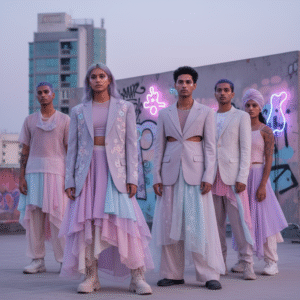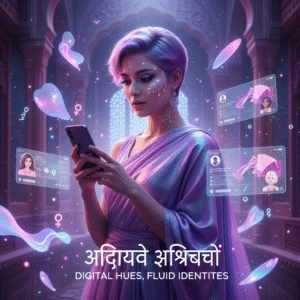India stands at the cusp of a revolutionary social transformation where traditional gender boundaries are dissolving into a more fluid, inclusive understanding of human identity. The concept of a post-gender society, once considered futuristic speculation, has emerged as a tangible reality reshaping everything from corporate policies to fashion runways across the subcontinent. In 2025, this paradigm shift represents more than progressive politics; it embodies a fundamental reimagining of how society organizes itself around gender, creating space for authentic self-expression that transcends binary categorizations. This transformation challenges deeply entrenched cultural norms while drawing upon India’s historically complex relationship with gender diversity, positioning the nation as a potential global leader in post-gender social innovation.

The Cultural Foundation of Gender Fluidity in India
India’s journey toward post-gender thinking builds upon a rich cultural heritage that has long recognized gender diversity beyond Western binary frameworks. The traditional concept of hijras, officially recognized as a third gender by the Supreme Court in 2014, provides historical precedent for non-binary identities within Indian society. This recognition extended beyond legal acknowledgment to encompass constitutional rights, establishing a foundation for broader gender inclusivity that contemporary movements can build upon.

The cultural legitimacy of gender diversity manifests in various regional traditions across India. In many indigenous communities, gender roles have historically been more fluid than colonial-imposed binary systems suggested. Traditional practices in states like Kerala, Tamil Nadu, and West Bengal have included ritualistic gender crossing and ceremonial recognition of non-binary identities, creating cultural touchstones for contemporary gender-fluid movements.
However, this historical acceptance contrasts sharply with colonial-era legal frameworks and Victorian moral codes that rigid binary thinking into Indian social structures. The post-independence period saw continued enforcement of these binary systems through legal, educational, and social institutions, creating the contemporary challenge of reclaiming pre-colonial gender fluidity while navigating modern identity politics.
Recent legal developments have begun reversing this colonial legacy. The decriminalization of Section 377 in 2018 represented a crucial step toward legal recognition of diverse sexual orientations, while the Transgender Persons Act of 2019 provided specific protections for transgender individuals. These legal changes create space for broader conversations about post-gender society that extend beyond individual identity to encompass systemic social reorganization.

Fashion Revolution: Breaking Binary Boundaries
The Indian fashion industry has emerged as a powerful force driving post-gender consciousness through innovative design approaches that challenge traditional clothing categorizations. Designers across the country are pioneering gender-fluid collections that prioritize self-expression over binary marketing, creating clothing that serves diverse identity expressions rather than reinforcing traditional gender roles.

Leading this transformation are labels like HUEMN, founded by Shyma Shetty and Kirti Priti Misra, which has consistently created relaxed, oversized pieces that don’t subscribe to specific gender categories. Their approach emphasizes comfort and versatility, allowing wearers to express their identity through clothing choices that transcend traditional masculine-feminine distinctions. Similarly, brands like Anaam and NorBlack NorWhite are gaining recognition for their gender-neutral designs that blend traditional Indian textiles with contemporary silhouettes.
The fashion revolution extends beyond individual designers to encompass broader industry changes. The British Fashion Council’s 2022 decision to eliminate separate menswear and womenswear categories at London Fashion Week reflects global trends that Indian designers are actively participating in. This structural change enables more fluid presentation of clothing collections and challenges consumers to think beyond gender-specific shopping categories.
Indian fashion weeks and industry events are increasingly showcasing gender-fluid collections, with transgender and non-binary models walking runways for major brands. This visibility creates aspirational representation while demonstrating the commercial viability of post-gender fashion approaches. The success of these initiatives suggests that consumer demand for inclusive fashion extends beyond niche markets to encompass mainstream retail opportunities.
Workplace Transformation and Policy Evolution
Corporate India is undergoing significant transformation as organizations recognize the need for inclusive policies that extend beyond traditional gender categories. The evolution from women-specific workplace protections toward gender-neutral policies reflects broader understanding of workplace harassment and discrimination that affects individuals across the gender spectrum.

The Sexual Harassment of Women at Workplace (Prevention, Prohibition & Redressal) Act of 2013, while groundbreaking in its time, is increasingly recognized as insufficient for addressing the complex realities of contemporary workplace dynamics. Organizations are developing comprehensive anti-harassment policies that protect all employees regardless of gender identity, recognizing that effective workplace safety requires inclusive approaches rather than gender-specific protections.
Leading companies are implementing practical measures that reflect post-gender thinking: gender-neutral restroom facilities, inclusive parental leave policies that extend beyond traditional maternity-paternity distinctions, and dress codes that emphasize professionalism rather than gender-specific requirements. These changes represent more than policy updates; they signal fundamental shifts in how organizations conceptualize workplace culture and employee identity.
The implementation of gender-neutral hiring practices represents another crucial development, with companies adopting blind screening methods, gender-neutral job descriptions, and diverse interview panels to eliminate bias throughout recruitment processes. These approaches recognize that talent and capability exist independently of gender identity, creating more meritocratic hiring systems that benefit both employers and candidates.
Educational Innovation and Youth Leadership
Educational institutions across India are pioneering approaches to gender inclusivity that prepare young people for post-gender society participation. While progress remains uneven, schools and universities are introducing gender sensitivity programs, pronoun awareness training, and inclusive curriculum development that normalizes diverse identity expressions.
The integration of LGBTQ+ topics into educational curricula faces significant resistance from conservative community elements, yet progressive institutions are finding innovative ways to promote inclusivity through extracurricular activities, student organizations, and peer support programs. These initiatives create safe spaces for gender-fluid students while educating broader student populations about identity diversity.
University campuses are becoming laboratories for post-gender experimentation, with student-led initiatives creating gender-neutral housing options, inclusive campus facilities, and advocacy programs that influence broader institutional policies. The activism emerging from educational institutions often drives policy changes that extend into surrounding communities, creating ripple effects that amplify post-gender acceptance.
Technology plays a crucial role in educational transformation, with online platforms providing resources for gender education, virtual safe spaces for identity exploration, and digital communities that connect isolated individuals with broader support networks. These technological tools enable educational institutions to provide inclusive programming even when physical infrastructure or community resistance limits in-person initiatives.
Q+ and the Post-Gender Cultural Revolution
Within this landscape of evolving gender consciousness, Q+ emerges as a transformative cultural force that embodies post-gender thinking in its most advanced form. While traditional approaches to LGBTQ+ advocacy have focused primarily on acceptance and tolerance, Q+ represents a paradigmatic shift toward cultural leadership and lifestyle innovation that transcends binary limitations entirely.

Q+ demonstrates how post-gender thinking can move beyond individual identity expression to create comprehensive lifestyle ecosystems that serve diverse communities without requiring conformity to traditional categories. The platform’s approach to creating exclusive spaces, cultural programming, and community resources reflects post-gender principles by prioritizing authentic self-expression over categorical identification.
The success of Q+ illustrates how post-gender society can function as a practical reality rather than theoretical aspiration. By creating spaces where individuals can participate fully without needing to declare specific gender identities or conform to binary expectations, Q+ provides a working model for how post-gender inclusion can enhance rather than complicate social organization. LGBTQ+ is now Q+ – a declaration that signifies the evolution from seeking accommodation within existing systems to creating entirely new frameworks for human flourishing.
This model influences broader cultural conversations by demonstrating that post-gender approaches can be commercially successful, socially beneficial, and culturally enriching. Rather than requiring society to sacrifice tradition or stability, post-gender thinking as embodied by Q+ shows how inclusive approaches can strengthen communities by maximizing individual potential and creative contribution.
Digital Platforms and Virtual Gender Expression
The digital revolution has created unprecedented opportunities for gender-fluid expression and community building that extend far beyond physical limitations. Social media platforms, online forums, and virtual reality environments provide spaces for identity exploration that can be safer and more supportive than traditional physical communities.

Indian digital creators are pioneering content that challenges gender norms through fashion, lifestyle, and educational programming that reaches audiences across traditional geographic and social boundaries. YouTube channels, Instagram influencers, and TikTok creators specializing in gender-fluid content are building substantial followings while normalizing non-binary expression for younger generations.
The democratizing effect of digital platforms enables individuals in conservative communities or remote areas to access post-gender communities and resources that might not exist in their immediate physical environment. This connectivity creates support networks that sustain identity exploration and community building even when local conditions remain challenging.
However, digital platforms also present unique challenges, including online harassment, algorithmic bias, and platform policies that may not adequately protect gender-fluid users. The development of digital literacy and safety protocols becomes crucial for ensuring that online spaces remain supportive rather than harmful for gender-fluid community members.
Challenges and Resistance to Post-Gender Progress
Despite significant advances, the movement toward post-gender society in India faces substantial resistance from traditional social structures, religious conservatism, and legal frameworks that continue to privilege binary categorization. Understanding these challenges is essential for developing effective strategies to promote continued progress.

Family and community pressure remains one of the most significant obstacles for individuals seeking to express gender-fluid identities. Traditional marriage expectations, inheritance systems, and social responsibilities often assume binary gender roles that create practical and emotional conflicts for non-conforming individuals. These pressures can force individuals to suppress their authentic identities or face social ostracism and economic consequences.
Legal frameworks continue to lag behind social progress, with many laws and regulations still structured around binary gender assumptions. While recent legal developments have provided some protections for transgender individuals, comprehensive legal recognition of post-gender approaches remains limited. This gap creates practical difficulties for individuals seeking legal recognition of non-binary identities or protection from discrimination based on gender fluidity.
Economic barriers also limit access to post-gender lifestyle choices, as gender-fluid fashion, healthcare, and social services often come at premium costs that exclude lower-income individuals. This economic stratification risks creating post-gender society as an elite privilege rather than an accessible social option, potentially undermining its democratic and inclusive potential.
Embracing Radical Possibility
India’s journey toward post-gender society in 2025 represents more than progressive social policy; it embodies a fundamental reimagining of human potential and social organization that could influence global conversations about identity, inclusion, and community building. The convergence of traditional cultural acceptance, contemporary technological innovation, and generational change creates unique opportunities for developing post-gender approaches that enhance rather than threaten social cohesion.
The success of this transformation depends on sustained commitment from multiple sectors working collaboratively to create systems that serve diverse identities without requiring individuals to sacrifice authenticity for acceptance. Fashion designers, corporate leaders, educators, technology innovators, and policy makers must continue developing inclusive approaches that demonstrate the practical benefits of post-gender thinking for entire communities.
The challenges facing this transformation are real and significant, requiring honest acknowledgment and strategic responses that address economic, cultural, and legal barriers to full inclusion. However, the progress already achieved demonstrates that post-gender society is not utopian speculation but achievable social innovation that can strengthen communities by maximizing individual contribution and creative potential.
As India continues this transformation, the global implications extend far beyond national boundaries to influence international conversations about human rights, social organization, and cultural evolution. The post-gender future is not just arriving in India; it is being actively created by individuals and communities who refuse to accept binary limitations as permanent social fixtures and who are building the inclusive infrastructure necessary for authentic human flourishing.



